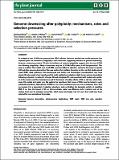Por favor, use este identificador para citar o enlazar a este item:
http://hdl.handle.net/10261/251572COMPARTIR / EXPORTAR:
 SHARE SHARE
 CORE
BASE CORE
BASE
|
|
| Visualizar otros formatos: MARC | Dublin Core | RDF | ORE | MODS | METS | DIDL | DATACITE | |

| Título: | Genome downsizing after polyploidy: mechanisms, rates and selection pressures |
Autor: | Wang, Xiaotong; Morton, Joseph A.; Pellicer, Jaume CSIC ORCID; Leitch, Ilia J.; Leitch, Andrew R. | Palabras clave: | Genome downsizing Whole-genome duplications DNA repair DNA loss rate Selection pressures |
Fecha de publicación: | 2-jun-2021 | Editor: | John Wiley & Sons | Citación: | Plant Journal 107, 4: 1003- 1015 (2021) | Resumen: | An analysis of over 10 000 plant genome sizes (GSs) indicates that most species have smaller genomes than expected given the incidence of polyploidy in their ancestries, suggesting selection for genome downsizing. However, comparing ancestral GS with the incidence of ancestral polyploidy suggests that the rate of DNA loss following polyploidy is likely to have been very low (4-70 Mb/million years, 4-482 bp/generation). This poses a problem. How might such small DNA losses be visible to selection, overcome the power of genetic drift and drive genome downsizing? Here we explore that problem, focussing on the role that double-strand break (DSB) repair pathways (non-homologous end joining and homologous recombination) may have played. We also explore two hypotheses that could explain how selection might favour genome downsizing following polyploidy: to reduce (i) nitrogen (N) and phosphate (P) costs associated with nucleic acid synthesis in the nucleus and the transcriptome and (ii) the impact of scaling effects of GS on cell size, which influences CO2 uptake and water loss. We explore the hypothesis that losses of DNA must be fastest in early polyploid generations. Alternatively, if DNA loss is a more continuous process over evolutionary time, then we propose it is a byproduct of selection elsewhere, such as limiting the damaging activity of repetitive DNA. If so, then the impact of GS on photosynthesis, water use efficiency and/or nutrient costs at the nucleus level may be emergent properties, which have advantages, but not ones that could have been selected for over generational timescales. | Versión del editor: | https://doi.org/10.1111/tpj.15363 | URI: | http://hdl.handle.net/10261/251572 | DOI: | https://doi.org/10.1111/tpj.15363 | Identificadores: | doi: https://doi.org/10.1111/tpj.15363 issn: 0960-7412 |
| Aparece en las colecciones: | (IBB) Artículos |
Ficheros en este ítem:
| Fichero | Descripción | Tamaño | Formato | |
|---|---|---|---|---|
| tpj.15363.pdf | 1,69 MB | Adobe PDF |  Visualizar/Abrir |
CORE Recommender
Page view(s)
203
checked on 15-abr-2024
Download(s)
221
checked on 15-abr-2024
Google ScholarTM
Check
Altmetric
Altmetric
Este item está licenciado bajo una Licencia Creative Commons

